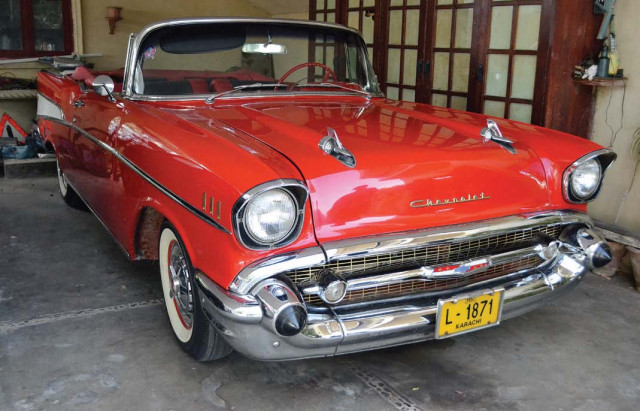
Though he normally drives a 2004 Vitz, he also takes to the road in his Riley Roadster and when you see Jim puttering on the streets of Karachi, you might think that he is driving a vintage car ... but you would be wrong. A vintage car is one that was manufactured between 1919 (end of World War I) and 1930, according to the British, though according to the Classic Car Club of America, the vintage era ends around 1925. All cars produced after that up till 1948, fall in the classic category. Beyond that time, you have what you call modern cars. However — and this does take a moment to digest — a modern car can also be an antique, since any car that is more than 45 years old can be termed antique. Agha’s car then is a modern car… and an antique car.
If all this seems like hairsplitting, talk to the people who collect and restore old cars. These distinctions are of paramount importance to a car enthusiast like Agha, who founded the Vintage and Classic Car Club of Pakistan along with Mohsin Ikram in 1986, to provide a platform for old car enthusiasts in Karachi. Since then, the club which holds Vintage and Classic Car shows all around the country, has opened a chapter in Lahore.
For some people, collecting and restoring old cars is merely a hobby, while for others it is life’s overriding (no pun intended) passion. Javed Ansari, who has been restoring cars since 1970, says, “I’ve always loved old cars.” Ansari, whose shiny, red 1957 Chevrolet stands quietly in his garage, derives pleasure mainly from restoring his cars, rather than displaying them. But many collectors relish the appreciation they get from others, which plays a big role in motivating them to continue with the activity. For Shahnawaz Khan, who currently owns a 1951 Armstrong Siddeley Sapphire Limousine which once belonged to the nawab of Bahawalpur, the most appealing aspect of the hobby is the admiration he gets from people on the road. “I like it when people see my car and feel good about it,” he says. On regular days, Khan drives a Toyota Premio but he loves the occasional thumbs up, while he’s out on the road on a Sunday in his Siddeley Sapphire. Khan has displayed his vehicles at several Vintage and Classic motor shows in the city and he loves the smiles and admiration on people’s faces. He is currently working on restoring a 1970 Austin 1100.
Giving new life to an old car is a mighty challenge and car enthusiasts associate a sense of achievement with the hobby. Given the lack of car parts, the effort put into finding the cars and the work that goes into making sure the final product is exactly the same as when it was first rolled out of a factory, it is a rather difficult task. But it is this very challenge that stimulates hobbyists. Mir Zubair Ahmed, standing in a makeshift workshop that he has constructed inside his house, points out, “For me it’s the challenge that comes with it.”
As one would expect from avid restorers, they are deeply
nostalgic. Their activity takes them back to a time when they were young and could not afford to buy expensive cars. “I started by looking at my neighbours. They used to have nice old cars,” reminisces Agha, who, like other car-lovers, enjoys reliving the past.
“It connects you to your past — to the world your parents lived in,” adds Ahmed, who has been working on old cars for the last 30 years.
In this respect, Madeehur Rehman stands out from the pack. At the age of 28, rather than reliving his past, this car-lover from Abbottabad is taking forward a legacy. An enthusiast since he was 14, Rehman explains that his grandfather and then his father were admirers of old cars and the love passed down to him.
But restoring old cars takes a considerable amount of time. “I spent nine years collecting parts before I started work on my cars,” says Ansari while talking about one of his many projects. “Before starting work on a project, we do all our research and find the required parts.”
While it may seem ridiculous to some that these men spend such a long time just collecting parts, to the enthusiasts it is this very quest that keeps them hooked. “Short cuts are easy, but then the originality goes away,” says Ansari stressing on the need to use original car parts. Ahmed on the other hand feels the longer the time spent on a car, the better. “It is food for my passion,” he says.
Original car parts for these vehicles are difficult to come by but car lovers are an unusually perseverant species. The major source of car parts in Karachi is a shop called Perfect Motors but many others are imported from the United States, UK or Germany, depending on the car. For the more flexible types, trips down to scrap markets are very good options as well.
“You have to know which car part you can fit in another car,” says Ahmed who frequently visits scrap markets for car parts. “Sometimes it hurts to see something very valuable crushed for its metal” which is later sold by its weight.
Time isn’t the only thing you need to indulge in this hobby — a great deal of money is needed as well.
Restoring old cars certainly isn’t a poor man’s game. Even the most enthusiastic car lovers admit that it is expensive. “At times it you may be asked Rs10,000 for something that really costs Rs500,” says Ahmed. “Other times you may find something that you would value at Rs20,000 for Rs200,” he adds.
However, Agha says, “Being rich does not mean you can get into restoring cars — it takes a lot of perseverance.”
While most enthusiasts say you need to work on the cars by yourself, they agree that they need a hand with tasks they simply aren’t qualified to perform.
“We have a team — a mechanic, a denter, a painter — that does what we tell them to,” says Ahmed. Ahmed used to extract motors out of his toys as a kid, but when it comes to his precious cars he explains, “There are certain things we cannot do with our own hands — it’s like those people who compose tunes but can’t sing.”
This is why it is important to keep your mechanic happy, says Khan. In fact there is a common saying among old car owners: “Be friendlier to your mechanic than your in-laws.”
Ansari is a strong believer in working by himself. “You can’t expect a car to be restored by giving it to someone else.”
Once an antique car is restored, it means a lot more than just means of transportation — it is a symbol of prestige and for some even more than that. “It is like bringing back something to life,” says Ahmed, of the sense of achievement that results.
“It is always a pleasure to see such cars on the road,” adds Rehman.
There are many among old car enthusiasts who keep their cars only for Sunday drives, while some adventurously take them out on city to city rallies. However, there are also those who believe in driving the cars regularly. “What is the point of having an old car if you can’t enjoy it?” says Ansar.
Published in The Express Tribune, Sunday Magazine, May 29th, 2011.








1726054615-0/OpenAI-(2)1726054615-0-270x192.webp)









COMMENTS
Comments are moderated and generally will be posted if they are on-topic and not abusive.
For more information, please see our Comments FAQ